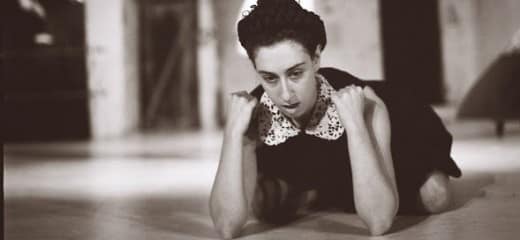I’ve seen a good amount of experimental dance, and heard a good amount of experimental music, but never experienced the two combined in quite the same way that Tatyana Tenenbaum pulled off in her new work Thunder. Rather than performing as dancers or musicians, each cast member became a truly hybrid cross, moving and sounding at the same time throughout the piece.
The women in the work, like a band of inscrutable post-modern mermaids, tossed off siren songs, cast longing glances heavenward and helped each other change costumes. Unconcerned with luring men to their deaths, these mermaids seemed fully occupied in working out their own complicated emotions and relationships. They did have full use of their legs, but it was the upper body movements that drew the eye; an arm jabbing the space repeatedly, as if adding punctuation, or held aloft in a rough, little-girl imitation of a ballerina.
The performance began with a remarkable gambit performed by Tenenbaum herself. She welcomed the audience and explained that she needed our help in warming up the space. We followed her instructions in making sounds coming from our bellies, then our upper chests, and finally from the crowns of our heads. Tenenbaum requested that we continue creating sounds as she exited the stage, and so the audience created a collective prelude to Thunder, producing a pleasant and tangible buzz in our bodies, and putting us in an optimal mind-set for receiving the work. (Later in the evening, I was struck by the improbability of what we were all doing there at the show, both as audience members and performers, and was brought back into the experience by remembering the sensation of singing. It was as if the introduction had unspooled an invisible thread that loosely bound the whole work together.)
Four dancers entered the space singing a chorus that initially sounded like “no-des-me” and gradually became intelligible as “notice me.” This slide into legibility was repeated in various forms, as well as reversed, as recognizable English later slid into gibberish. There was a sweetness and innocence to their stage presence, as if the quartet had wandered away from an experimental version of The Sound of Music.
In one section, the performers opened their mouths, but despite trying, nothing came out. The effort looked painful, even though they were smiling at times. I wondered who was keeping these women from singing, what was keeping them from finding their voices. My discomfort was made more acute by the memory of the strange and beautiful music they had been producing only a few minutes before. The group’s droning, chanting, singing or vocalizing was sometimes accompanied by live percussion by Eric Derr, invisibly perched on a balcony above the stage.
Another memorable section looked like a line dance at a club. It began as a tightly scripted forward-back side-to-side throw-the-arm-out and pivot, and then dissolved into a wilder thing in which the dancers put their individual spin on the movements, at one point leading to a joyful collision.
Tenenbaum is the third recipient of Temple University’s Reflection: Response commission; the work was made for the Conwell Dance Theater on campus, set on a core group of Tenenbaum’s collaborators joined by a group of Temple students. In the post-show Q&A, as Tenenbaum was describing how the group worked with phonemes, I was surprised by how young she is to have found such an interesting and unique area of excavation, and how certain she seems that she’s digging in the right place. Her particular style of integration of music and dance, with both elements given equal weight and development, seems like a genre unto itself.Thunder, Tatyana Tenenbaum, Conwell Dance Theater, Temple University, October 24-25.






